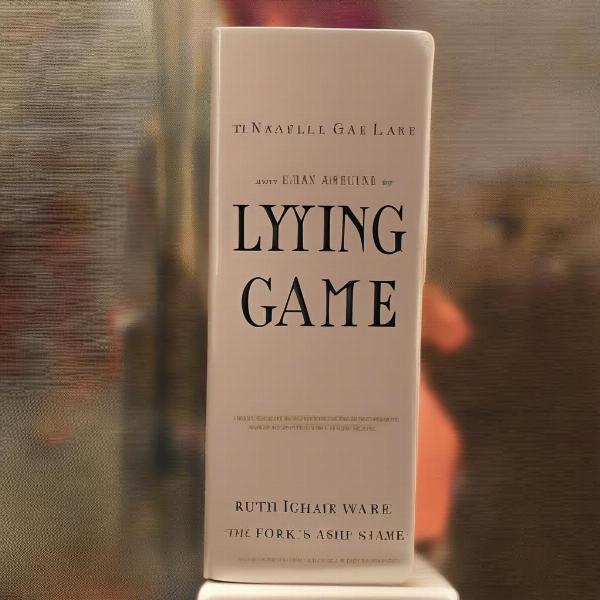Here at SupremeDuelist.blog, we’re always on the hunt for narratives that grip us from the first page and refuse to let go. Ruth Ware’s “The Lying Game” is one such thriller, masterfully weaving a tale of friendship, secrets, and the dark undercurrents that can simmer beneath the surface of seemingly ordinary lives. This novel draws readers into a world where the past refuses to stay buried, and the lines between truth and deception become increasingly blurred.
In this deep dive, we’ll explore the intricate plot of “The Lying Game,” examine the compelling characters that drive the story, and analyze the themes that resonate throughout Ware’s suspenseful masterpiece. We’ll also unpack the core of what makes this novel such a captivating read and touch on why it continues to intrigue audiences. This examination will offer insight into the literary elements that contribute to its success, as well as explore the broader appeal of psychological thrillers in contemporary literature.
The Enigmatic Plot of “The Lying Game”
At its core, “The Lying Game” revolves around a group of four women: Isa, Thea, Kate, and Fatima. Their friendship, forged during their school years at the unconventional Salten School, is tested when they receive a chilling text message, “I need you.” This simple text throws them back into a tangled web of shared secrets and past traumas from their boarding school days. The story then alternates between the present-day reunion and flashbacks to their time at Salten, gradually revealing the nature of their “lying game” and the disturbing events that led to its cessation years prior.
The game itself involved a series of escalating lies, designed to shock and challenge one another. This behavior, seemingly innocent in its inception, reveals a far more sinister side when secrets from the past resurface to haunt the present. The seemingly harmless childhood game morphs into a present danger, forcing the women to confront a past they had all tried desperately to bury. The narrative pacing is carefully calibrated, doling out information in small, tantalizing morsels that keep readers constantly guessing.
 book-cover-lying-game
book-cover-lying-game
The Core Mystery: What Really Happened at Salten?
The central mystery driving “The Lying Game” is, of course, what exactly happened at Salten School and why the women’s shared past continues to hold them captive. The novel deftly layers secrets upon secrets, revealing the true nature of the game and the events that led to its end. Readers are taken on a journey through the characters’ unreliable narrations and shifting perspectives, making the mystery all the more engaging and compelling. The narrative is a masterclass in suspense, as every answer offered gives way to more questions, drawing the reader deeper into the complex puzzle.
- Unreliable Narrators: The story is told from Isa’s perspective, but her recollections are often hazy and colored by her own perceptions, making it difficult to discern fact from fiction.
- Flashbacks and Foreshadowing: Ware cleverly uses flashbacks and subtle hints to build a sense of dread and anticipation, constantly reminding readers that a dark truth is lurking just beneath the surface.
- Secrets Within Secrets: The novel is not only about one big secret but rather many smaller secrets woven together, each holding a piece of the puzzle.
“The beauty of ‘The Lying Game’ lies in its subtle manipulation of the reader’s perception, drawing them into the complicated and often contradictory lives of the protagonists,” says Dr. Eleanor Vance, a professor of literary analysis. “Ware excels at creating a narrative that keeps us guessing until the very end.”
Characters and Their Complexities
The characters in “The Lying Game” are far from simple. Each woman carries her own burden of guilt and unresolved trauma, adding layers of complexity to the story. Isa, as the narrator, is a particularly compelling character, her vulnerability and self-doubt drawing readers into her turbulent inner world. The other members of the quartet—Thea, the bold and outspoken leader; Kate, the enigmatic and secretive one; and Fatima, the quiet and observant—also present distinctive personalities that interact dynamically, both during their school years and their present-day reunion.
The intricate web of relationships between the women are a central aspect of the narrative. Their decades-long bond, seemingly unbreakable, is tested by long-buried lies and resentments. The women’s past shapes their present actions, making their interactions tense with an underlying fear of exposure. The story reveals that their time at Salten, meant to foster independence and growth, actually became a breeding ground for dangerous secrets and unchecked emotions.
Exploring Character Motivations
Understanding the motivations of the four protagonists is key to unlocking the mysteries of “The Lying Game”. Each character is driven by her past experiences, which heavily impact their interactions, actions, and the choices they make. Here’s a closer look:
- Isa: Driven by guilt and a desperate need to understand her past, she is often hesitant and uncertain.
- Thea: She is portrayed as the strong one, but she harbors deep secrets and insecurities.
- Kate: Enigmatic, her silence and secretiveness make her the most unpredictable of the group.
- Fatima: The quiet observer, her sharp insights and hidden fears often reveal unexpected dimensions to the narrative.
 four-friends-walking-together
four-friends-walking-together
“What makes the characters of ‘The Lying Game’ so captivating is that their flaws are just as prominent as their strengths. They’re not perfect heroes or villains; they’re deeply human, making their conflicts and resolutions that much more resonant,” states Samuel Hawthorne, a professor of psychology with a focus on literary characters.
Thematic Analysis: Secrets, Guilt, and the Past
Beyond the captivating plot and complex characters, “The Lying Game” also explores compelling themes. The weight of secrets, the corrosive power of guilt, and the enduring impact of past actions are central to the story. Ware masterfully illustrates how unresolved traumas can haunt individuals and seep into their relationships, affecting their present lives in profound ways.
The novel questions whether it’s possible to truly escape one’s past and whether some secrets are better left buried. It reveals the dark side of close-knit friendships and how loyalty can be tested by guilt, deception, and the fear of exposing the truth. The story is a cautionary tale about the consequences of one’s actions and the ethical implications of seemingly harmless games gone wrong.
Key Themes:
- The Burden of Secrets: The novel vividly illustrates how hidden secrets can weigh down and ultimately destroy individuals and relationships.
- The Corrosive Effects of Guilt: The characters struggle with the burden of their past actions, revealing how guilt can lead to paranoia and self-destruction.
- The Enduring Power of the Past: “The Lying Game” demonstrates how the past can constantly reappear in the present, influencing choices and shaping identities.
- The Nature of Truth: The novel questions the validity of different narrations and the reliability of personal recollections.
- The Complicated Nature of Friendship: The narrative exposes the complexities of intense friendships and how quickly the bond can unravel when trust is broken.
Why “The Lying Game” Remains So Popular
“The Lying Game” continues to resonate with readers because of its masterful blend of suspense, complex characters, and thought-provoking themes. The novel’s exploration of the darker side of human nature, combined with a narrative that keeps readers guessing until the very end, makes it a compelling read for those who appreciate psychological thrillers. Ware’s writing style creates a constant state of anticipation, drawing readers into a world where trust is a fragile thing.
This story’s success also lies in its relatability. The characters are not perfect and face common struggles such as guilt, insecurity, and the fear of judgment. These human flaws make the characters relatable and deeply compelling, giving readers a sense of genuine engagement with the narrative. The intricate plot structure, with its clever use of flashbacks and multiple perspectives, creates a layered narrative that encourages multiple readings, each time uncovering new nuances within the tale.
 ruth-ware-author-portrait
ruth-ware-author-portrait
Questions Answered
What is the central conflict in “The Lying Game”?
The central conflict in “The Lying Game” stems from a group of friends’ shared past and the secrets they harbor, which come to light when a cryptic text message pulls them back together, forcing them to confront the truth about their childhood game and its aftermath.
What makes the characters in “The Lying Game” so intriguing?
The characters are intriguing because they are flawed and complex, with hidden motivations and unresolved trauma that drive their actions. Their imperfections and vulnerabilities make them relatable and contribute to the suspenseful atmosphere of the story.
How does Ruth Ware use flashbacks in “The Lying Game”?
Ruth Ware uses flashbacks to reveal the characters’ past, gradually exposing the disturbing events that led to the present conflict. This technique creates suspense and provides deeper insight into the characters’ motivations and relationships, enriching the overall narrative.
What is the “lying game” exactly?
The “lying game” was a disturbing activity where the characters, as teenagers, would intentionally lie to and deceive each other and other individuals. It is eventually revealed that the game was much more dangerous and had further-reaching consequences than was initially apparent, serving as the primary conflict of the book.
What role does setting play in “The Lying Game”?
The setting of Salten School, with its isolated location and unconventional atmosphere, plays a crucial role. It fosters an environment where secrets thrive and the girls’ unconventional upbringing makes their “lying game” more understandable in the context of the story.
Conclusion
Ruth Ware’s “The Lying Game” remains a captivating read due to its intricate plot, complex characters, and thought-provoking exploration of secrets and the past. This novel excels in crafting suspense and drawing readers into its tangled web of lies and revelations, reminding us of how the past can haunt the present. The layered narrative provides depth and encourages a deeper reflection on the characters’ actions.
Here at SupremeDuelist.blog, we appreciate a well-crafted thriller and “The Lying Game” certainly delivers on all fronts. For readers looking for a suspenseful and thought-provoking read, Ruth Ware’s novel is a must-explore. So dive into the secrets and see if you can untangle the truth before the final page. We encourage you to share your thoughts in the comments below or engage further with our other literary analysis pieces.
Leave a Reply